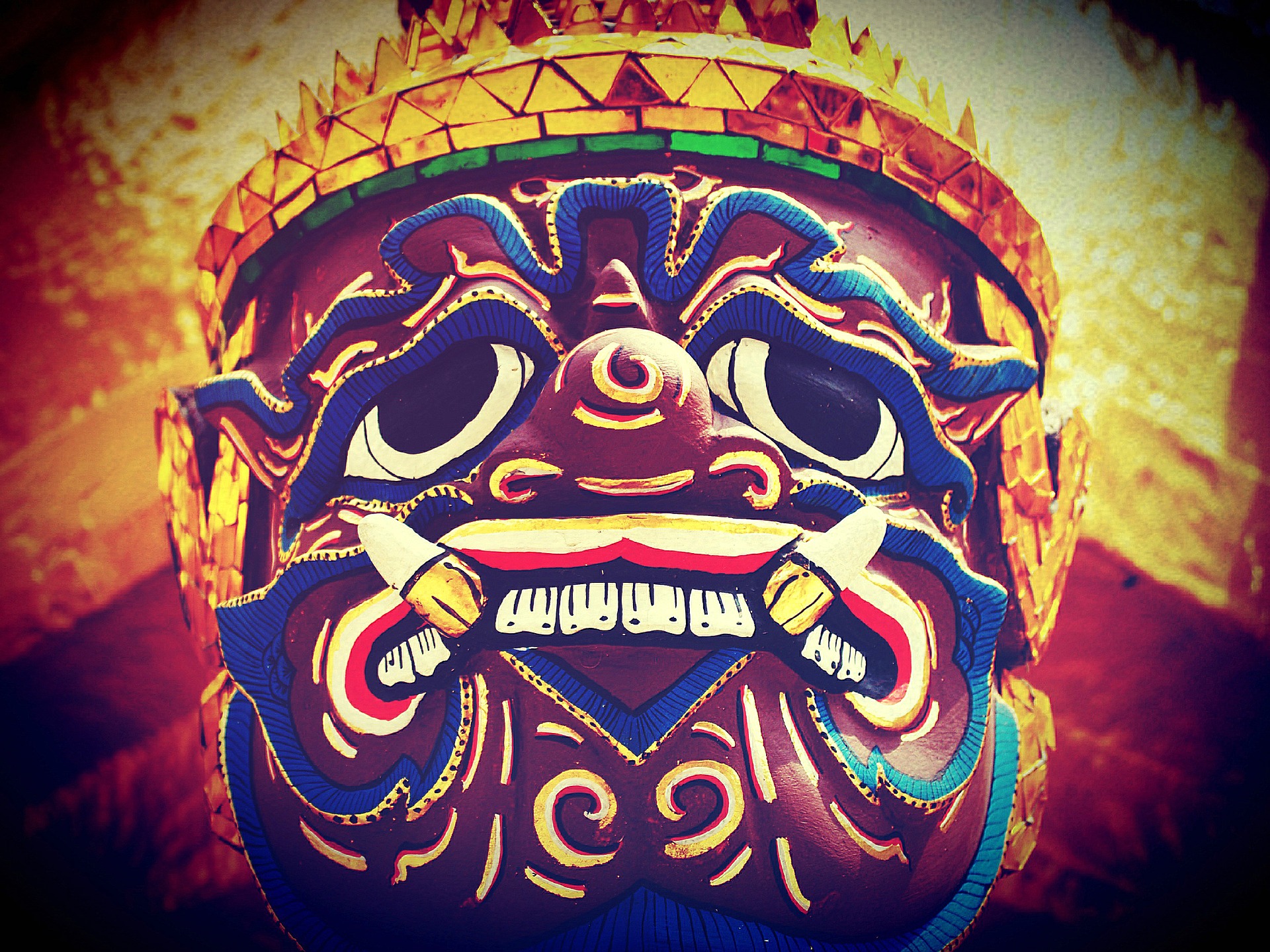 Submitted by Krishna Dhanya on
Submitted by Krishna Dhanya on

In the Hindu mythology there are many demons. Unlike Christianity, the demons are not the cause of the evil and unhappiness in present humankind (which occurs on the account of ignorance from recognizing one's true self). Many people metaphorically interpret these demons as manifestations of the ignoble passions in the human mind - negative actions, chosen actions of humans along their soul’s journey toward Nirvana. Such behaviors result in negative karma and a regression to a lower form upon death and reincarnation. The soul then has another opportunity to correct the bad karma and move back to a higher form in its next life.
Here is a list of some prime characters:
Andhaka
In Hindu mythology, Andhaka (Sanskrit: he who darkens) often refer to a malevolent asura who is killed by Shiva for trying to abduct Parvati out of lust.
Bhuta
A bhoot or bhut is a supernatural creature, usually the ghost of a deceased person, in the popular culture, literature and some ancient texts of the Indian subcontinent Interpretations of how bhoots come into existence vary by region and community, but they are usually considered to be perturbed and restless due to some factor that prevents them from moving on (to transmigration, non-being, nirvana, or heaven or hell, depending on tradition). This could be a violent death, unsettled matters in their lives, or simply the failure of their survivors to perform proper funerals Bhuta also refers to five elements: Akasha (ether), Vayu (wind), Agni (fire), Prithvi (earth), Ap (water). On the other hand,
Kali
Kali is an immortal and powerful Hindu demon. Kali is the Hindu goddess (or Devi) of death, time, and doomsday and is often associated with sexuality and violence but is also considered a strong mother-figure and symbolic of motherly-love. Kali also embodies shakti - feminine energy, creativity and fertility - and is an incarnation of Parvati, wife of the great Hindu god Shiva. She is most often represented in art as a fearful fighting figure with a necklace of heads, skirt of arms, lolling tongue, and brandishing a knife dripping with blood.
Koka and Vikoka
Koka and Vikoka are figures from Hindu mythology, twin generals who will aid the demon Kali in his battle against Kalki, the 10th and final avatar of the god Vishnu, whose coming will herald the end of the age.
Panis
They are a class of demons in the Rigveda, from paṇi-, a term for "bargainer, miser," especially applied to one who is sparing of sacrificial oblations.
Pishacha
These are flesh-eating demons in Hindu mythology. Their origin is obscure, although some believe that they were created by Brahma.
Rakshasas
A race of evil mythological beings (man-eaters), but living in solitary places. Rakshasas are mentioned in a number of Puranic books and the Mahabharata.
Vetala
The vetala are a class of demons in Hindu mythology that are vampires. They have the power to enter the bodies of human or animal corpses and reanimate them. They can enter living victims as well, and manipulate them as they please. Generally, though, the vetala stick to inhabiting the bodies of dead people. This myth is also connected with burial rites or, in some cases, the circumstances of a person’s death. If a body is buried improperly or does not receive the proper rites, the body is in danger of becoming possessed by a vetala.
Vinayakas
Vinayakas are a group of four troublesome demons who create obstacles. In the Puranic literature of a much later period, the group of four Vinayakas was merged into one deity named Vinayaka whom Rudra (Shiva) appointed as the "Leader of the Ganas".
Vipracitti
Chief of the Danavas (analogical to Greek Titans) - a powerful race of giants almost always at war with gods. Kasyapa’s (Kasyapa was the grandson of Lord Brahma) wife Danu (a daughter of Daksha) had many sons and the word "Danavas" is derived from her name. Among the demons (who were resisting the armies of King Indra) were Namuci, Sambara, Anarva, Dvimurdha, Rsabha, Asura, Hayagriva, Sankusira, Vipracitti, Ayomukha, Puloma, Vrsaparva, Praheti, Heti and Utkala
Virabhadra
Also known as Veerabathira,Veerabathiran,Veeraputhiran is a fearsome form of the Hindu god Shiva. Virabhadra is a patron of occult practices. He has temples, too. One of such temples is, for example, in Mylapore (a southern part of Chennai in the Indian state of Tamil Nadu). Shiva created him to help Him fight with Daksha.
Resources:
http://national-paranormal-society.org/hindu-beliefs-on-demons/
http://www.newworldencyclopedia.org/entry/Demon
https://en.wikipedia.org/wiki/Rakshasa
https://www.britannica.com/topic/rakshasa
http://www.sacred-texts.com/evil/hod/hod09.htm
https://www.deliriumsrealm.com/demons/asian-demons/
https://en.wikipedia.org/wiki/Panis
https://en.wikipedia.org/wiki/Pishacha
https://en.wikipedia.org/wiki/Andhaka
https://en.wikipedia.org/wiki/Kali_(demon)
https://www.ancient.eu/Kali/
https://en.wikipedia.org/wiki/Koka_and_Vikoka
https://en.wikipedia.org/wiki/Vinayakas
https://vaniquotes.org/wiki/Among_the_demons_(who_were_resisting_the_armies_of_King_Indra)_were_Namuci,_Sambara,_Anarva,_Dvimurdha,_Rsabha,_Asura,_Hayagriva,_Sankusira,_Vipracitti,_Ayomukha,_Puloma,_Vrsaparva,_Praheti,_Heti_and_Utkala
https://en.wikipedia.org/wiki/Virabhadra
https://en.wikipedia.org/wiki/Bhoot_(ghost)
- 1906 reads